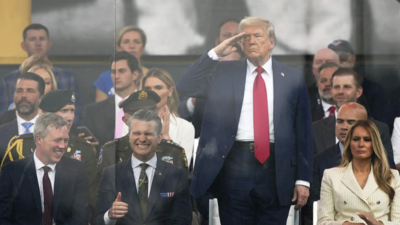Trump at 79: Tanks roll, protests surge, and the Middle East burns; Inside US president’s most volatile week

As Donald Trump turned 79, the spectacle of a military parade in the capital, complete with tanks and chants of “USA! USA!” offered a vivid image of power. But beneath the optics of strength lay a presidency teetering on chaos, both at home and abroad. In just eight days, Trump’s grip on his second-term presidency has been jolted by political ruptures, domestic rebellion, and a spiraling Middle East conflict — all while he celebrated his birthday with an event critics decried as authoritarian theater.This past week may go down as one of the most consequential and combustible stretches of the Trump era, an eight-day crucible in which symbolism, statecraft, and street power collided.
Chaos at home: Tanks on parade, tear gas in the streets
The week began with headlines dominated by Trump’s dramatic fallout with tech magnate Elon Musk, once seen as a vital bridge between Silicon Valley and MAGA Republicans. But the rupture with Musk was merely the opening act.Days later, Trump invoked rarely used powers to federalise the National Guard and deploy 700 Marines to Los Angeles, without the consent of California’s governor, to suppress protests triggered by his administration’s aggressive immigration raids. The move was unprecedented in the post-Civil Rights era and drew fierce constitutional backlash.When senator Alex Padilla attempted to question DHS secretary Kristi Noem at a press conference, he was forcibly removed in handcuffs — a moment that quickly went viral and galvanised a new wave of demonstrations under the banner of “No Kings.”On Saturday, an estimated 1,800 cities saw large-scale protests. While most remained peaceful, flashpoints of violence erupted — including in Salt Lake City, where a protester was critically wounded in a shooting, and in Los Angeles, where police deployed tear gas and flash-bangs ahead of a curfew.Then came the parade.Held on a gray evening in Washington, the military display was Trump’s long-cherished dream — a pageant modeled more on Moscow than the Mall. Tanks rumbled past the White House, aircraft roared overhead, and 7,000 troops marched by as Trump watched, saluted, and declared the US military “fights, fights, fights, and wins, wins, wins.”Yet just miles away, protestors denounced the display as a “dictator’s birthday gift to himself.” The parade cost taxpayers up to $45 million, and critics saw it as more than excess — a deliberate symbol of Trump’s tightening grip on power amid rising civil unrest.
Abroad, a foreign policy legacy unravels
If Trump once promised “no new wars,” the Middle East this week came perilously close to proving him wrong.As the president basked in domestic spectacle, Israel launched one of the most audacious covert strikes in modern memory: targeted assassinations, missile facility sabotage, and the bombing of Iranian nuclear sites. Despite Trump’s public plea for restraint and his pursuit of a nuclear deal with Tehran, Israel acted unilaterally.While Trump insisted the operation — carried out with “great American equipment” — could still bolster diplomatic leverage with Iran, the region is now on edge. Iran retaliated with missile strikes against Israeli targets, some intercepted with US assistance. Oil prices spiked. American bases braced for blowback.This chain of events now risks erasing Trump’s prized foreign policy narrative: that under his leadership, America avoided entanglement in new conflicts. Even his MAGA base — long skeptical of foreign wars — has expressed unease. Tucker Carlson, a key voice of Trumpian populism, warned that aiding Israel could violate the movement’s core tenets: “Drop Israel. Let them fight their own wars.”What was meant to be a demonstration of strength has instead revived ghosts of the “forever wars” Trump campaigned against — and could fracture his political coalition.
What it all means: Theatrics or turning point?
At first glance, Trump’s week may seem like more of the same: rallies, bluster, and polarisation. But the convergence of events — federal troops deployed on American soil, a military parade eerily evocative of autocratic regimes, a senator in handcuffs, and a potential regional war — marks something deeper: a turning point.The White House appears to be leaning into confrontation, willing to provoke Democrats, governors, and protestors alike. The aim: to consolidate executive power, galvanise the base, and frame opposition as unpatriotic or anarchic. But the backlash is growing, and the consequences may already be escaping the administration’s control.Even Trump’s inner circle seems aware of the risks. The president largely avoided his usual political invective in his birthday speech — a rare moment of restraint — but his warnings to adversaries, both foreign and domestic, were unmistakable.The past eight days were not just chaotic — they were transformative. They revealed a president more embattled and emboldened than ever, attempting to wrap nationalism, militarism, and executive force into a coherent image of leadership.





